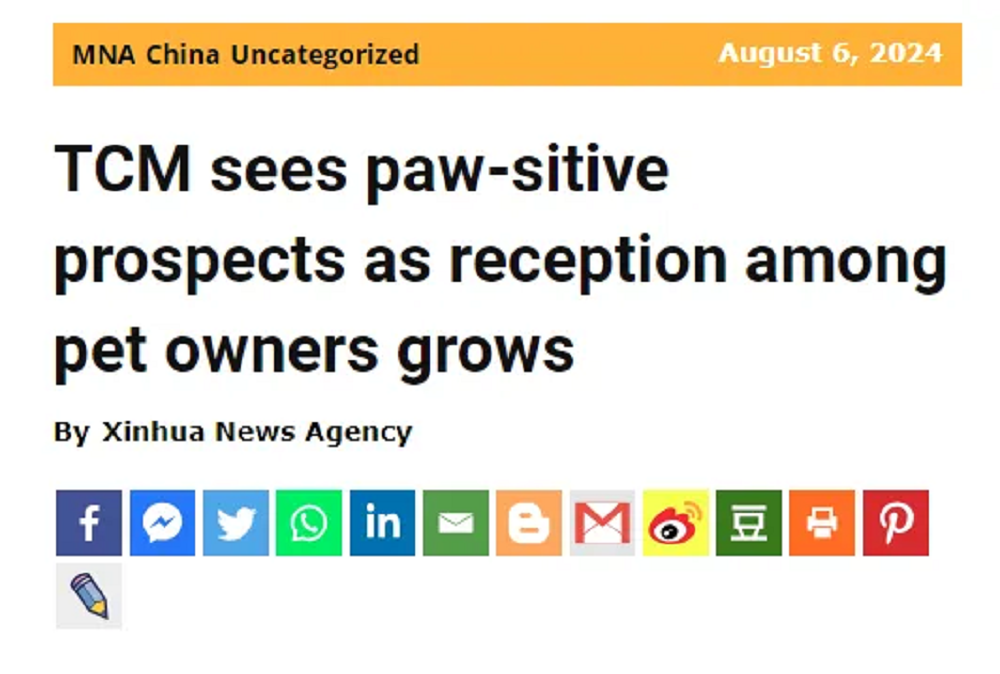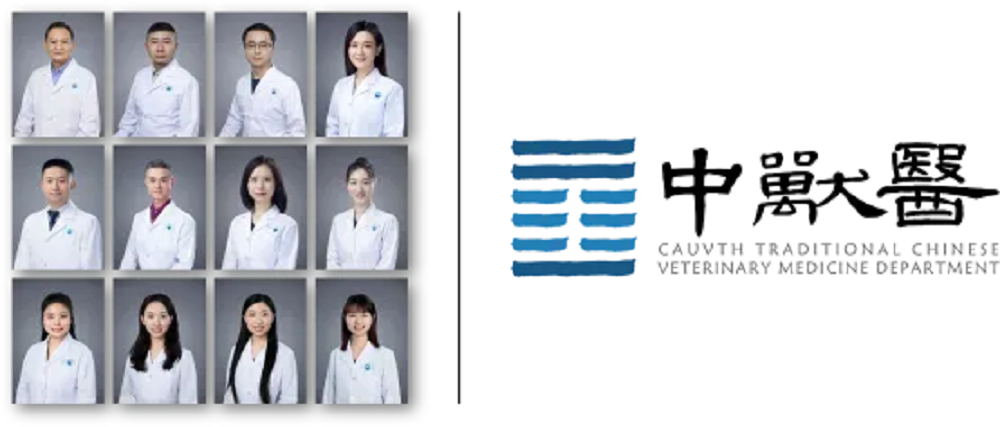发布时间:2024-09-1808:55:57浏览量:1955次

近日,新华社记者到中国农业大学动物医院对中兽医专科进行了采访报道。并在新华网英文版和海外媒体等渠道发布了文章,将我院中兽医专科能为动物主人解决的问题及效果进行了国际报道。
报道指出越来越多的宠物主人对中兽医感兴趣,中国农业大学动物医院中兽医专科负责人胡宇声医生也表示,现在前往中兽医专科看诊的的患宠数量与疾病复杂程度都有所攀升。“当动物治疗效果不佳又缺乏特效药物或治疗手段时,许多主人会带动物来到中医诊室寻求帮助,而对于老年动物的慢性疾病、复杂共病等,中兽医的治疗方式会更加安全简洁、副作用少。面临肿瘤、免疫相关的疑难杂症以及复杂的血液病时,中兽医往往会发挥意想不到的神奇疗效。”
如今,中兽医已经走出国门,继续发挥着它的价值,也有越来越多的学生选择中兽医专业学习。“传承精华,守正创新”。中兽医是中华优秀传统文化在农业领域非常典型的代表。从古代到现代,无论是理论还是临床,它都在传承发扬。
以下内容为新华网英文报道全文(报道内容来自 Xinhua News Agency):
BEIJING, Aug. 6 (Xinhua) -- A short video of a distressed golden retriever recently went viral on China's social media. The video showed the dog with squinting eyes, a drooling face, and a peculiar array of "thorny" needles on its nose.
These needles were acupuncture pins. According to the vet in the video, the dog was receiving this traditional treatment to alleviate symptoms of facial paralysis.
The video has sparked curiosity about the enigmatic traditional Chinese medicine (TCM) for canines and felines.
Although it may seem novel to many, the traditional Chinese method for treating animal illnesses, including paralysis, is far from new.
This practice even has its own name -- traditional Chinese veterinary medicine, or TCVM.
Hu Yusheng, a TCVM practitioner at China Agricultural University Veterinary Teaching Hospital, diagnoses and treats about 40 pets every Sunday during his office hours.
The number has kept rising, and so has the complexity of the illnesses. "Most pet owners who come here have exhausted all other options, and their beloved pets are often referred from some other hospitals with a notice of critical illness," he said.
Hu's fluffy patients recently included a dog suffering from gallstones in the bile duct.
Since the 7-year-old dog had undergone gallbladder removal surgery last year due to a severe rupture, his owner, Sun Jie, decided to explore an alternative to Western medicine to alleviate the symptoms.
Sun said that after a year of acupuncture and herbal medicinal treatment, the B-scan images showed that his dog's gallstones had become much smaller.
And the TCM treatments cost only a fraction of an invasive surgery. Regular acupuncture therapy, for example, costs about 300 yuan (about 41 U.S. dollars) each time.
Known for its philosophy of "full life-cycle care," TCVM is popular among China's pet owners for its preventive and therapeutic methods throughout an animal's life, including infancy, middle age, old age, and sometimes even hospice care.
"I raised Naonao from when she was just an 8-month-old puppy. I love her just like my own child," said Li Shengwen, the owner of a 12-year-old Chow Chow.
In January last year, when CT scans revealed multiple metastatic tumors in Naonao's abdomen, Li was devastated.
The vets Li consulted recommended euthanasia. Given Naonao's very poor condition, it was highly likely she would not survive a surgery. However, without intervention, her illness could deteriorate at any moment and lead to her death.
Overwhelmed by grief, Li sought help from Hu's clinic, hoping Naonao could live as fully and comfortably as possible in her final days.
After a month of acupuncture and herbal medicine treatments, Naonao's appetite improved and her condition began to get better.
"Naonao could bark, run after me, and interact with guests at home -- just as energetic as a normal dog!" Li said.
Though Hu could not save her, Naonao lived her last eight months with quality and dignity before passing away in September.
TCVM adopts a holistic approach to wellness and disease treatment. Like TCM, it uses four diagnostic methods -- inspection, listening and smelling, inquiry, and pulse-taking -- to identify symptoms and develop tailored therapies.
However, there are some distinctions. For example, when assessing a puppy or kitten, the pulse is taken from the femoral artery in the hind legs.
Through the integration of new technologies into TCM, innovations such as electro-acupuncture and laser therapy have been introduced in TCVM to better address and meet the needs of treatment for animals.
As China's pet economy booms, TCM is emerging as a valuable complement to Western medicine in animal care and treatment. As of 2023, urban China is home to over 120 million pet dogs and cats, according to the Pet Industry White Paper 2023-2024 (Consumption Report) released by Petdata.cn, a pet industry market observer.
"Individualized treatments are in great demand for pets, which is exactly what TCVM treatments offer," said Fan Kai, an associate professor of the College of Veterinary Medicine at the China Agricultural University.
"Pet owners showed their preference by gravitating toward this service," Hu said. "Last year, about one in every eight cases handled by our hospital sought TCVM treatments at some point."
Despite the growing popularity, there is a dire shortage of TCVM professionals in China. Only about six colleges offer undergraduate majors related to traditional Chinese veterinary medicine, and these institutions enroll about 200 students annually.
To bridge the gap, the Ministry of Education has mandated compulsory courses in TCVM for all veterinary medicine students and launched TCVM courses online on a national platform for vocational education.
"TCVM carries the fine traditional culture of the Chinese nation. I believe it will have a brighter future and be even more popular domestically and globally," Hu said.
中国农业大学教学动物医院
中兽医专科简介
中国农业大学教学动物医院在上世纪90年代开设小动物中兽医门诊,是国内最早将中兽医学方法运用于犬猫临床诊疗的单位之一。前辈奋楫扬帆,我辈赓续前行。经过近30年的奋斗与沉淀,中国农业大学教学动物医院中兽医专科已形为国内规模最大,治疗范围最全面,专科构架最完善的小动物中兽医团队。本着“多维度全生命周期介入,治疗保健强生于一体”的理念,专科年接诊量逾万例,以中药、针灸、食疗等中兽医特色疗法为临床提供更多优质选择。
